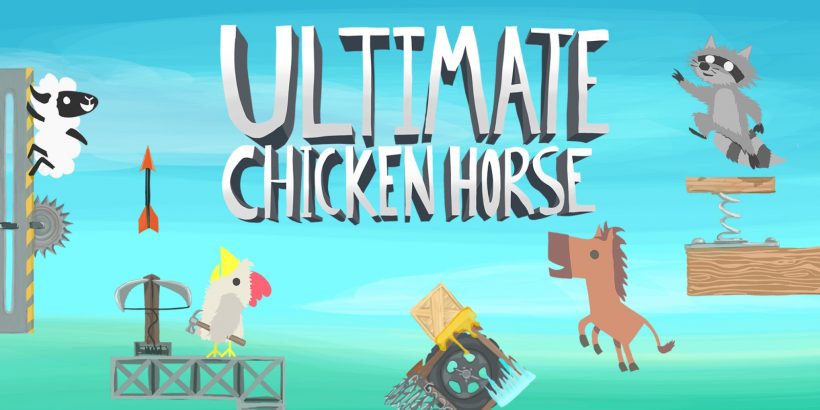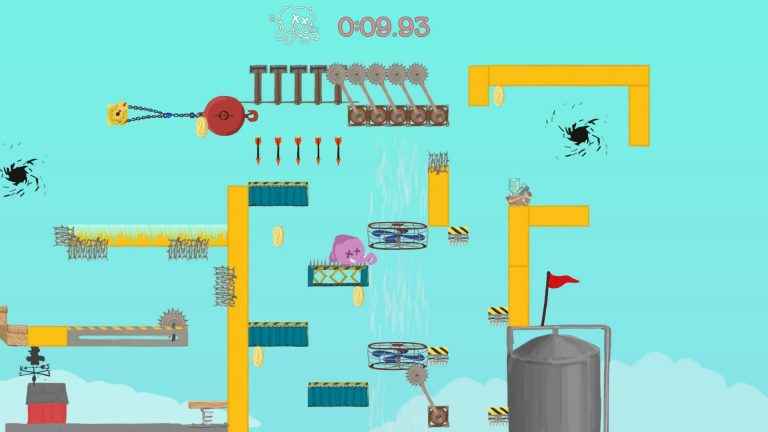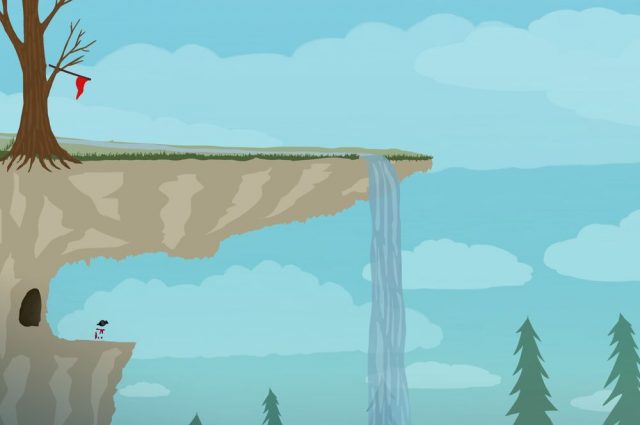
Ultimate Chicken Horse is a party game that plays out as a platformer game (think Mario). The aim of the game is simple, get from the starting point of the map to the endpoint and make sure no one else does it. No points are awarded if all the players are able to complete the course. To do so, players are given the choice of various platforms and traps that they can put on the map before the start of each round. The player who has the highest number of points at the end of a set number of rounds wins the game and is the ULTIMATE ANIMAL!
Link to steam page: https://store.steampowered.com/app/386940/Ultimate_Chicken_Horse/
Lens 9: The Elemental Tetrad
COVID19 and the subsequent closures had introduced us to a slew of party games ranging from Among Us to the Jackbox line of games. Ultimate Chicken Horse however proved to be a fresh of breath air compared to those as the game is simple enough such that there was no real need to overthink each and every one of your actions. As a party game, I would put it to be closest to something like Mario Party minigames where you have to achieve a simple objective before the rest of the players do.
As far as mechanics go, the game is alike most generic platformers – you could jump, spring to gain a higher vertical height and wall jump. However adding the ability to modify the environment as you play more rounds adds a whole lot more dynamism to the gameplay. One round could be simple, needing only to jump on platforms to reach the goal. Suddenly all hell breaks lose in the next round as a wrecking ball, 2 arrow turrets and a black hole is added to the level. As you go through multiple rounds, each round feels similar but yet has some additions or removal that changes the experience of the level. This also makes it infinitely replayable as no two levels will ever feel the same. The gameplay is very well designed. I was in awe as to how they were able to take a tried and tested genre in platformers and convert it into a chaotic and interactive experience for a party. And yet the mechanics were nothing new which makes you feel “Why didn’t I think of making something like this?”.

The artstyle is simple. The characters you play are doodled animals in a cartoonish world. This however adds to the game’s charm as a cute family-friendly game (barring some of the death weapons used). You unlock new characters and cosmetics as you progress through the game but I found myself not being too focused on this. The gibberish that the animals make while it jumps, dies or celebrates however adds to the whimsical nature of the game which makes even being turned into a shish kebab by an arrow turret light-hearted.
The game itself does not require powerful hardware to run given its simple graphics. It’s available on multiple platforms on consoles as well as PC. I however found that it is best played on the Nintendo Switch which already has built-in controllers that can be used for multiple players. This adds to convenience factor of not needing to have multiple controllers and makes the pairing process seamless. The option to play online with others exists but nothing beats being physically present with your friends to enjoy their reactions to getting killed by your spike trap.
The game has really no story elements but that is completely alright since the bulk of the game is in the gameplay. If anything the stories are the funny incidents that happen while playing that you end up recalling and sharing with others (read: friends you make along the way).
Lens 8: Problem Solving
Unlike the way I played most platformers, I noticed that my approach to each new round in Ultimate Chicken Horse to be more methodical. For something like the classic Sonic games, I would dive head first into the level with speed without regard for discerning the optimal path. In Ultimate Chicken Horse however, I would usually chart out a path before hand, and ensure to understand the timing of my moves in order to get to the goal. If it is clear the route is not viable, I would reevaluate the other possible options and test them out. This introduces an element of Problem Solving where one has to find a viable approach to reach the endpoint of the specific round.
Such a map state is also reached because of the decision making process that each player has to go through when placing their platforms or traps. The players have to choose an item and location to place on the map such that they are able to reach the end goal while making sure that other players are not able to do so. This could lead to really complex levels which are technically possible to complete but require some form of thought and technique. Obviously there are situations where the level is impossible to complete and in such a state, the game will offer bombs to destroy previously placed elements of the map. The player with the bomb will then have to think of which obstacles to remove and which to keep such that the level does not become too easy.
Lens 34: Skill
Having grown up with platformer games such as Mario, Megaman and Super Smash Bros, I was very familiar with the movesets in Ultimate Chicken Horse. I knew how to time my jumps after a sprint in order to get the maximum vertical and horizontal distance, I knew how to wall jump effectively and most importantly, I knew how to avoid projectiles coming my way. This meant that even though it was the first time all of us were playing the game, my experience had given me a sizeable advantage. Some of the newer platformer players kept lamenting how my character had a higher jumping height compared to theirs when I did a sprint jump.

For a party game, this disparity could quickly become problematic since it is meant to be something that can be enjoyed by casual players. To this end, the game added some balancing mechanisms like the handicap system which allowed you to reduce the percentage of points that select players would receive. I personally didn’t think this was the ideal solution, but it did achieve the effect that it intended so I guess I can’t argue with the results.
Lens 27: Time
By default, each round had no time limit. This meant that players could take their time in order to complete the round. The round would only finish when all of the players are either dead or have reached the end point. The implication of this is that there are times where a single player would struggle to reach the end-zone . The players who are done with the stage would then be unable to do anything other than watch the remaining player struggle their way through the map. For an otherwise polished game, this was a source of frustration since they have to wait an undisclosed amount of time for their next in game action. There is however some sense of balancing in play where the dead/successful players can heckle the remaining player in order to pressure them to fasten their pace. This is another benefit of playing the game physically together as compared to online where the heckling can only be auditory.
Lens 45: Competition vs Cooperation
Undoubtedly, Ultimate Chicken Horse is a competitive game. There can only be one Ultimate Animal. Some level of cooperation however, is required in order to be able to reach the end-goal in the first place. This is especially true at the start of each level where there are no items in place on the level which means there is a need to build a path together.

There is a constant need to evaluate the current position and choose between messing up the stage further or making it easier. If you are not in the lead, there may be a need to make the level slightly easier so that you will be able to gain points on the leader. On the other hand you wouldn’t want to make it too easy as everyone would be able to complete the level, resulting in no points. The fine balance between working together and cooperating with other players to build something workable adds depth to the seemingly simple game.
Lens 2: Essential Experience
That said, I love to play as the embodiment of chaos and making rounds absurdly difficult. In the end, party games are built to create interactions between players. This involves eliciting reactions from other players as well as the playful banter that arises from the occurrences in-game. The gameplay alone could be fun but it would be no different from a single player game if you are unable to mess around and have fun with the people you’re with. And to that end, I think being chaotic suits the purposes of the game.
